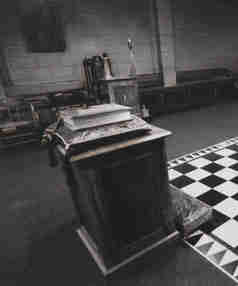




Taranaki Daily News - New Zealand
http://www.stuff.co.nz/taranaki-daily-news/life-style/5641588/Secret-societies
Secret societies
18/09/2011
ARTHUR FRYER

The subject of many a tall tale. The altar in a Masonic lodge. |
The Hawera Forester's Hall now holds demolition doors, windows and timber and is called the Handyman's Barn and the Orange Hall, the Oddfellows Hall and the Buffalo Hall have long been demolished to be replaced by commercial buildings.
Some of the halls were those of the Masonic Order. The Freemasons of the British Isles had a long history evolving into three slightly different forms, the Grand Lodge of Ireland, the Grand Lodge of Scotland and the Grand Lodge of England and each had members in New Zealand from the 1840s.
Most of these Masonic Constitutions came together in 1890 to form the Grand Lodge of New Zealand and to build their lodge buildings in almost every town and village.
A feature in common with all of these men's organisations was the wearing of aprons and sashes and addressing each member by a grand title and following rituals known only to those who had been instructed in the craft.
The Masonic Lodge is similar to the Friendly Societies, who other halls were named for, but whose objectives were not the same.
Friendly Societies were descended from Burial Societies that had been established in 18th century England by groups who wished to ensure that their members and their families were able to have attention from doctors and decent funerals.
The establishment of the Oddfellows Lodges gave rise to many other similar organisations such as the British Workman's Lodge that flourished in Hawera in 1900.
Until the mid 20th century Friendly Societies met regularly to enjoy one another's company, for self-improvement and perhaps plan public events such as picnics or athletic meetings.
But Friendly Societies were vital for people living in pre-social security times to be an insurance against illness and death. The members' regular contributions were invested for them to be paid out for doctors' visits in times of injury to them or their family.
In 1869 the Taranaki Herald recorded the celebrations that attended the 11th anniversary of the beginning of New Plymouth's Independent Order of Oddfellows.
The members of the Loyal Egmont Lodge began with a parade to St Mary's church at three in the afternoon, the members wearing their full regalia, and were addressed by the Venerable Archdeacon Govett, who spoke on the importance of brotherly love as the founding principle of the lodge.
At six the members sat down in their hall to a substantial feast presided over by Mr Harris Ford, of the Egmont Lodge, and flanked by Archdeacon Govett and J S McKellar Esq.
Following the meal was a long toast list from the Queen, the Governor, the Chief Justice, the Army, Navy, Armed Constabulary and Volunteers.
The Lodge Secretary, Mr W F Brooking, responding to a toast to the Manchester Unity, told the party about the Order of Odd Fellowship's study of the sickness and mortality of members that had allowed a compilation of rates of contributions and benefits to members that had been done in England during 1850 and 1860.
"It is the duty of every man who earns his bread by the labour of his hands to provide against times of sickness, for the decent burial of himself and his wife and the endeavour to leave something for the widows and orphans he leaves behind."
After several more toasts and long replies, the chairman proposed a toast to the Surgeon of the Lodges, Dr Paddy O'Carroll, who had been called away to attend a patient. Lodge surgeons gained a reliable income from lodge members as well as assuring them when they were fit enough to return to work and go off the tiny sickness benefit.
Each lodge had not only an interest in the self-improvement of members but also in the life of the community, though they would not allow the discussion of politics inside their walls.
The Wesley Methodist Church in Hawera has two foundation stones, one on each side of the broad flight of steps up to the front doors. One commemorates the building of the third church on that site, the previous two having been outgrown, and the second stone was laid by the Hawera Masonic Lodge or, as they were officially known, "Grand Lodge of the Ancient Free and Accepted Masons".
On November 9, 1905, the King's birthday, the congregation of the Hawera Methodist Church met with full choir and an orchestra to celebrate the laying of the foundation stone of their new church building.
They were joined by a Masonic procession of members wearing the full regalia of their craft led by Brother George Corkill, the Grand Superintendent of Taranaki.
The Masonic stone was lowered into place first with all the speeches and ceremony associated with such occasions and it was set into place by a highly polished square, level, plumb rule and mallet.
The second foundation stone was laid by the Rev Hammond and Mr E Dixon, assisted by Mr Barraclough, before the congregation hurried off to the Town Hall pursued by showers of rain. A packed Town Hall was the site for a handsome banquet with the official speeches first planned for the outdoor function.
The governments of New Zealand had long looked for ways of looking after the sick, the penniless and the aged members of the community and it was not until the passing of the 1938 Social Security Act that the many pieces of legislation were pulled together and a common entitlement to health and welfare was laid down. The age of the Friendly Societies had passed and their myriad of halls became redundant.
The Welfare State had arrived.
Further Reading: